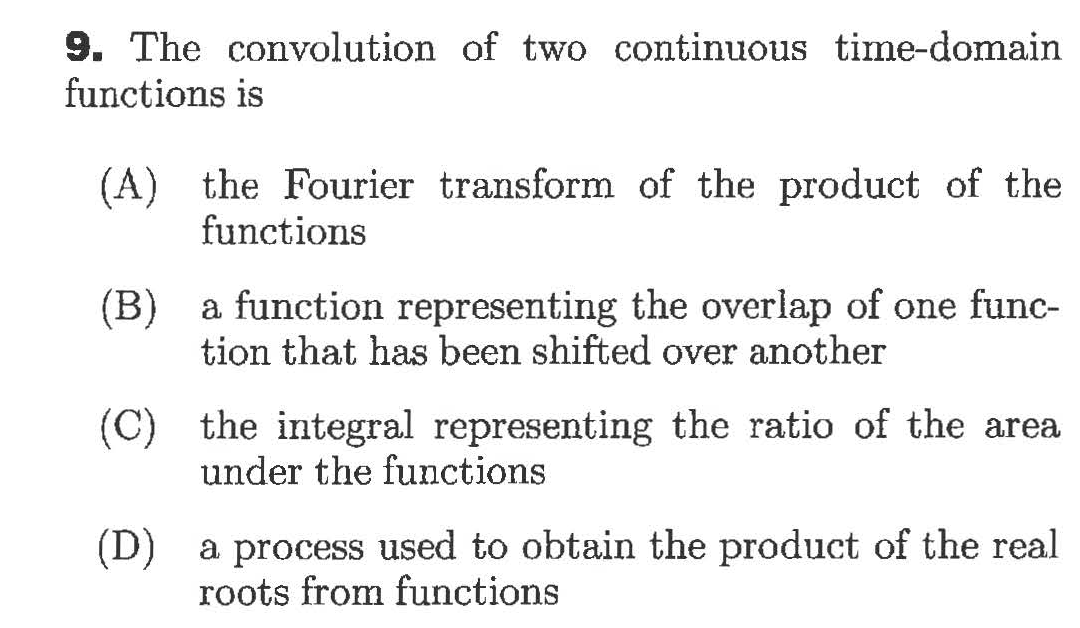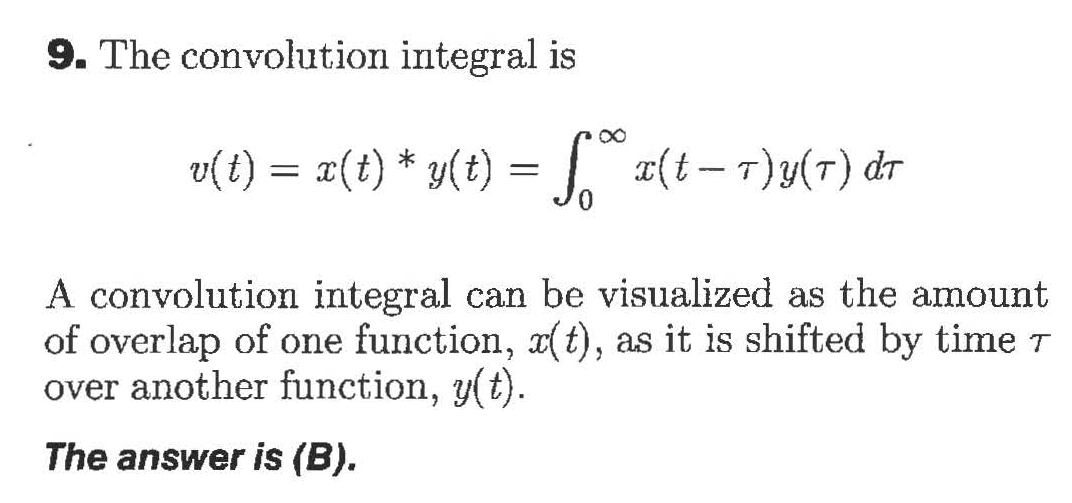9. The convolution of two continuous time-domain functions is (A) the Fourier transform of the product of the functions (B) a function representing the overlap of one func- tion that has been shifted over another (C) the integral representing the ratio of the area under the functions (D) a process used to obtain the product of the real roots from functions 9. The convolution integral is = x(t-7)y(T) dr v(t) (t) y(t) A convolution integral can be visualized as the amount of overlap of one function, x(t), as it is shifted by time T over another function, y(t). The answer is (B).
9. The convolution of two continuous time-domain functions is (A) the Fourier transform of the product of the functions (B) a function representing the overlap of one func- tion that has been shifted over another (C) the integral representing the ratio of the area under the functions (D) a process used to obtain the product of the real roots from functions 9. The convolution integral is = x(t-7)y(T) dr v(t) (t) y(t) A convolution integral can be visualized as the amount of overlap of one function, x(t), as it is shifted by time T over another function, y(t). The answer is (B).
Introductory Circuit Analysis (13th Edition)
13th Edition
ISBN:9780133923605
Author:Robert L. Boylestad
Publisher:Robert L. Boylestad
Chapter1: Introduction
Section: Chapter Questions
Problem 1P: Visit your local library (at school or home) and describe the extent to which it provides literature...
Related questions
Question
100%
Hi,
the attached image shows a question and its answer but still, I couldn't understand it please simply explain it

Transcribed Image Text:9. The convolution of two continuous time-domain
functions is
(A) the Fourier transform of the product of the
functions
(B)
a function representing the overlap of one func-
tion that has been shifted over another
(C) the integral representing the ratio of the area
under the functions
(D)
a process used to obtain the product of the real
roots from functions

Transcribed Image Text:9. The convolution integral is
= x(t-7)y(T) dr
v(t) (t) y(t)
A convolution integral can be visualized as the amount
of overlap of one function, x(t), as it is shifted by time T
over another function, y(t).
The answer is (B).
Expert Solution
This question has been solved!
Explore an expertly crafted, step-by-step solution for a thorough understanding of key concepts.
This is a popular solution!
Trending now
This is a popular solution!
Step by step
Solved in 5 steps with 5 images

Knowledge Booster
Learn more about
Need a deep-dive on the concept behind this application? Look no further. Learn more about this topic, electrical-engineering and related others by exploring similar questions and additional content below.Recommended textbooks for you

Introductory Circuit Analysis (13th Edition)
Electrical Engineering
ISBN:
9780133923605
Author:
Robert L. Boylestad
Publisher:
PEARSON

Delmar's Standard Textbook Of Electricity
Electrical Engineering
ISBN:
9781337900348
Author:
Stephen L. Herman
Publisher:
Cengage Learning

Programmable Logic Controllers
Electrical Engineering
ISBN:
9780073373843
Author:
Frank D. Petruzella
Publisher:
McGraw-Hill Education

Introductory Circuit Analysis (13th Edition)
Electrical Engineering
ISBN:
9780133923605
Author:
Robert L. Boylestad
Publisher:
PEARSON

Delmar's Standard Textbook Of Electricity
Electrical Engineering
ISBN:
9781337900348
Author:
Stephen L. Herman
Publisher:
Cengage Learning

Programmable Logic Controllers
Electrical Engineering
ISBN:
9780073373843
Author:
Frank D. Petruzella
Publisher:
McGraw-Hill Education

Fundamentals of Electric Circuits
Electrical Engineering
ISBN:
9780078028229
Author:
Charles K Alexander, Matthew Sadiku
Publisher:
McGraw-Hill Education

Electric Circuits. (11th Edition)
Electrical Engineering
ISBN:
9780134746968
Author:
James W. Nilsson, Susan Riedel
Publisher:
PEARSON

Engineering Electromagnetics
Electrical Engineering
ISBN:
9780078028151
Author:
Hayt, William H. (william Hart), Jr, BUCK, John A.
Publisher:
Mcgraw-hill Education,